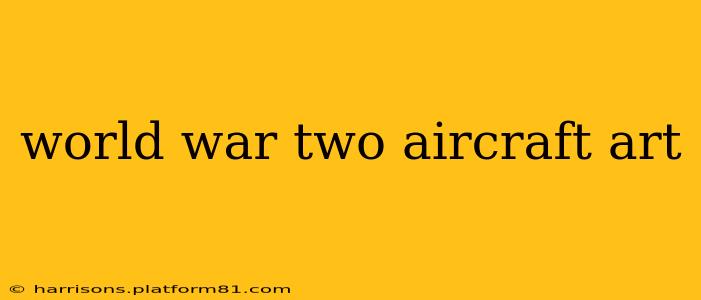World War II aircraft art offers a captivating glimpse into a pivotal moment in history, capturing the beauty, power, and brutality of the conflict through a variety of artistic styles and mediums. From meticulously detailed paintings to evocative sketches and powerful sculptures, this art form serves as a poignant reminder of the machines that played a crucial role in shaping the 20th century. This exploration delves into the diverse world of World War II aircraft art, examining its historical context, artistic styles, and lasting legacy.
What are the most famous examples of World War II aircraft art?
Several pieces stand out as particularly iconic examples of World War II aircraft art. These often depict famous aircraft, pivotal battles, or the emotional experiences of pilots and ground crews. While specific titles and artists can vary depending on the collector's and historian's perspectives, some frequently cited examples feature:
-
Portraits of iconic aircraft: Paintings and drawings showcasing the detailed artistry of planes like the Spitfire, Mustang, Zero, and B-17 Flying Fortress are commonly seen. These often emphasize the sleek design and technological marvel of these machines.
-
Depictions of air battles: Dynamic scenes depicting dogfights, bombing runs, and aerial combat capture the intensity and danger of warfare in the skies. These pieces often focus on the drama and skill involved in aerial combat.
-
Portraits of airmen: Art featuring pilots, navigators, and other crew members highlights the human element of the war, showcasing their courage, resilience, and sacrifices.
It's important to note that defining "most famous" can be subjective and depends on individual preferences and exposure to various collections and museums. However, these categories encapsulate recurring themes within the genre.
What different artistic styles were used to depict World War II aircraft?
The artistic styles employed in World War II aircraft art are diverse, reflecting the broader artistic trends of the time and the individual preferences of the artists. Some common styles include:
-
Realism: This style meticulously depicts aircraft and scenes with a high degree of accuracy and detail, emphasizing the technical aspects of the planes and the realism of the battle scenes.
-
Impressionism: Although less common in depicting the stark reality of war, some artists used impressionistic techniques to capture the fleeting moments and emotional impact of aerial combat.
-
Abstract Expressionism: While not as prevalent as realism, some post-war artists used abstract expressionism to convey the emotional turmoil and trauma associated with the conflict.
-
Propaganda Art: Governments used art to boost morale and inspire patriotism during the war. This propaganda art often showcased aircraft in a heroic light, emphasizing their power and the prowess of the pilots.
Who were some of the most influential artists who created World War II aircraft art?
While a comprehensive list is impossible here, identifying prominent artists requires further research specific to the medium (painting, sculpture, etc.) and national context. Many artists contributed to this genre, both during and after the war. Some focused on meticulous realism, while others leaned toward more abstract or impressionistic styles. Researching specific museums and galleries specializing in World War II art will provide more precise information on influential figures in this field.
How did World War II aircraft art reflect the experiences of pilots and ground crews?
World War II aircraft art often serves as a powerful testament to the experiences of pilots and ground crews. Many pieces capture the intense emotions associated with combat, including fear, courage, camaraderie, and loss. Some works illustrate the psychological toll of war, highlighting the trauma and stress endured by airmen. The art also portrays the daily lives of ground crews, mechanics, and support staff, showing their crucial role in the war effort.
What is the historical significance of World War II aircraft art?
World War II aircraft art holds significant historical value for several reasons. It serves as a visual record of the technology and weaponry of the era, accurately documenting the design and appearance of different aircraft models. Furthermore, it offers a unique perspective on the human experience of war, capturing the emotions, challenges, and sacrifices of those involved. The art also reflects the broader cultural and political context of the time, providing insights into the propaganda, morale, and national identity during the conflict. In this way, it helps future generations understand and appreciate this pivotal period in history.
Where can I find examples of World War II aircraft art?
Many museums and galleries worldwide house collections of World War II aircraft art. Online resources, such as specialized websites and auction houses, also provide access to numerous examples. Conducting thorough online searches and checking the collections of aviation museums will be beneficial in finding further examples and expanding your knowledge. Note that private collections also exist, and accessing them may require further research and potentially specialized connections.
